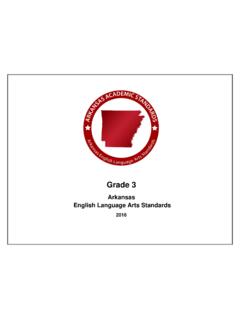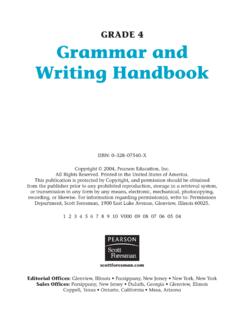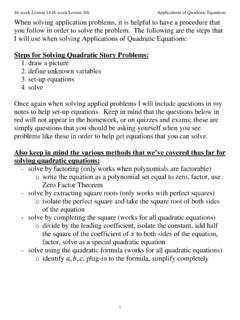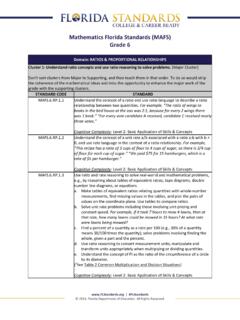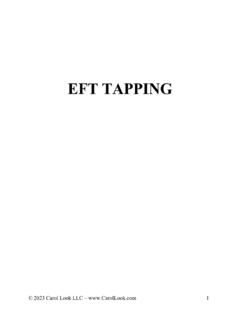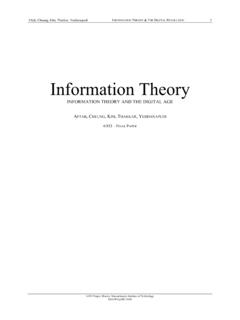Transcription of Arkansas Mathematics Standards Grades 6-8
1 Arkansas Mathematics Standards Grades 6-8 2016 Introduction to the Grades 6-8 Arkansas Mathematics Standards When charged with the task of revising the previous Mathematics Standards , a group of qualified individuals from across the state came together to craft Standards that were specific for the schools and students of Arkansas . The result of this work, the Arkansas Mathematics Standards , is contained in this document. These Standards reflect what educators across our state know to be best for our students. These Standards retain the same structure as the previous Standards in terms of organization.
2 The Standards are organized by domains, clusters, and Standards . Domains represent the big ideas that are to be studied at each grade level and sometimes across grade bands. These big ideas support educators in determining the proper amount of focus and instructional time to be given to each of these topics. Clusters represent collections of Standards that are grouped together to help educators understand the building blocks of rich and meaningful instructional units. These units help students make connections within clusters and avoid seeing Mathematics as a discreet list of skills that they must master.
3 Standards represent the foundational building blocks of math instruction. The Standards outlined in this document work together to ensure that students are college and career ready and on track for success. There are additional similarities shared by these new Standards and the previous Standards . The main similarity is the structure of the nomenclature. The only change that was made to the naming system was intended to reflect that these Standards belong to Arkansas . However, educators may still search for open education resources by using the last part of the label, which will link to the resources for the previous Standards .
4 New Standards can be found at the end of each cluster in which a new standard was deemed necessary. Another similarity to the previous Standards is the use of the symbols (+) and (*) to distinguish certain Standards from others. The plus (+) symbol is used to designate Standards that are typically beyond the scope of an Algebra II course. However, some of the plus (+) Standards are now included in courses that are not considered to be beyond Algebra II. Standards denoted with the asterisk (*) symbol represent the modeling component of the Standards . These Standards should be presented in a modeling context where students are required to engage in the modeling process that is outlined in the Standards for Mathematical Practice.
5 The revision committee opted to include some new elements in the Arkansas Mathematics Standards that represent an attempt at greater clarity and more consistent implementation across the state. Many of the revisions are a rewording of the original Common Core State Standards . The purpose of the rewording is often to help educators better understand the areas of emphasis and focus within the existing standard. Likewise, many of the Standards are separated into a bulleted list of content. This does not mean that teachers should treat this content as a checklist of items that they must teach one at a time.
6 The content was bulleted out so that teachers can better understand all that is included in some of the broader Standards . Many of the examples that were included in the original Standards were either changed for clarity or separated from the body of the actual standard. The committee wanted educators to understand that the examples included in the body of the Standards document in no way reflect all of the possible examples. Likewise, these examples do not mandate curriculum or problem types. Local districts are free to select the curriculum and instructional methods they think best for their students.
7 In some instances, notes of clarification were added. These notes were intended to clarify, for teachers, what the expectations are for the student. Likewise, these notes provide instructional guidance as well as limitations so that teachers can better understand the scope of the standard. This will help the educators in determining what is developmentally appropriate for students when they are working with certain Standards . Finally, the Arkansas Mathematics Standards will become a living document. The staff of the Arkansas Department of Education hopes that this document portrays the hard work of the Arkansas educators who took part in the revision process and that it represents an improvement to the previous set of Standards .
8 As these Standards are implemented across schools in the state, the Arkansas Department of Education welcomes further suggestions related to notes of clarification, examples, professional development needs, and future revisions of the Standards . Abbreviations: Ratios and Proportional Relationships RP The number System NS Expressions and Equations EE Geometry G Statistics and Probability SP Functions F Grade 6 Arkansas Mathematics Standards 3 Ratios and Proportional Understand ratio concepts and use ratio reasoning to solve problems Understand the concept of a ratio and use ratio language to describe a ratio relationship between two quantities For example, "The ratio of wings to beaks in the bird house at the zoo was 2:1, because for every 2 wings there was 1 beak.
9 " "For every vote candidate A received, candidate C received nearly three votes." Understand the concept of a unit rate a/b associated with a ratio a:b with b 0, and use rate language in the context of a ratio relationship For example, "This recipe has a ratio of 3 cups of flour to 4 cups of sugar, so there is 3/4 cup of flour for each cup of sugar." "We paid $75 for 15 hamburgers, which is a rate of $5 per hamburger." Note: Expectations for unit rates in this grade are limited to non-complex fractions. Use ratio and rate reasoning to solve real-world and mathematical problems ( , by reasoning about tables of equivalent ratios, tape diagrams , double number line diagrams , or equations): Use and create tables to compare equivalent ratios relating quantities with whole- number measurements, find missing values in the tables, and plot the pairs of values on the coordinate plane Solve unit rate problems including those involving unit pricing and constant speed For example.
10 If it took 7 hours to mow 4 lawns, then at that rate, how many lawns could be mowed in 35 hours? At what rate were lawns being mowed? Find a percent of a quantity as a rate per 100 ( , 30% of a quantity means 30/100 times the quantity) Solve problems involving finding the whole, given a part and the percent Use ratio reasoning to convert measurement units; manipulate and transform units appropriately when multiplying or dividing quantities Example: How many centimeters are in 7 feet, given that 1 inch cm? Note: Conversion factors will be given. Conversions can occur both between and across the metric and English system.
